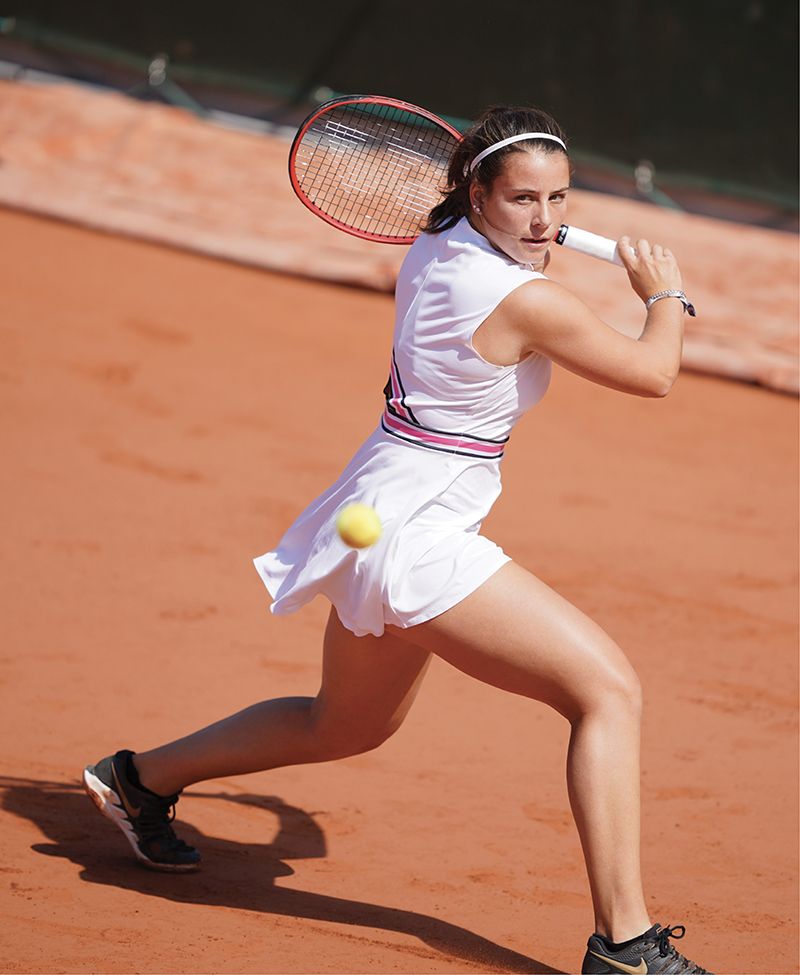The local makes a second appearance at the Volvo Car Open

Emma Navarro, who practiced at the Hazel Parker Playground courts as a child, takes a swing during the 2019 Roland-Garros Junior Championships.
Born: 2001, New York City
Lives: Downtown Charleston with her parents and siblings
College Career: A freshman at University of Virginia, where she’s the school’s No. 1 women’s tennis player, Emma Navarro has her sights set on a pro-tennis career and another trophy at the French Open at Roland-Garros.
While the Volvo Car Open is being played without fans on-site this year, plenty of Charlestonians will be glued to the action on TV, cheering for Emma Navarro, who is making her second appearance in her hometown tournament. The tennis prodigy (she’s the daughter of tournament owner Ben Navarro) picked up a racquet at age three at the Hazel Parker Playground courts. The Ashley Hall graduate completed her junior run as the No. 3 junior singles player in the world, having played all four majors, taking home the French Open Junior Doubles Championship trophy, and finishing as the runner-up in singles. Navarro, who was the No. 1 recruit in the country in high school, is attending the University of Virginia. Here, she talks about the game, the Volvo Car Open, and her career aspirations.
CM: How did you get into tennis, and why do you love it?
EN: My dad always said he wanted it to be a family sport. I have two older brothers, and they both played. As soon as I was old enough and strong enough to hold a racquet, I was out there on the court with them. What I love about this sport is the nuance of it. It’s not just athleticism, skill, talent, or the mental game; it’s everything combined. I love the challenge of attempting to master that.
CM: How did growing up with the Volvo Car Open being played here affect your career?
EN: Going to watch the best female players in the world every year was definitely an inspiration. It’s different seeing them in person versus seeing them on TV; it seems more plausible. When I was younger, it seemed like a long shot that I would be able to play in that stadium. But I always knew it was something I wanted to do. And when it happened, it was great [Navarro made her World Tennis Association Tour debut at the 2019 Volvo Car Open, losing narrowly to German Laura Siegemund].
CM: How do you balance being an athlete and going to college?
EN: Working hard in school has always come first, but it’s a challenge. I’ve had lots of years of practice balancing the two. In fourth grade I started training before school, getting up at 5 a.m. to go hit. I was late every morning. My teachers were so fed up with me. And then I would train after school, too. I didn’t see it as a burden, I just saw it as something that I did.
CM: When did you realize tennis was something you wanted to potentially turn into a career?
EN: I don‘t think there was a specific day or time when I had some sort of enlightenment. When I started meeting success, working my way up the regional and national rankings, playing for the Junior International Tennis Federation, I realized there’s a possible path for me, and this could be something that I could pursue longer term.
CM: Who has been a mentor to you?
EN: My dad has always been in my corner, getting me the coaching and training, whatever I needed. My coach, Peter Ayers, is the most dedicated man I’ve ever met. He’ll do whatever it takes to give me what I need or help me to improve. He’s been a really great mentor for me. And my mom—she’s the behind-the-scenes lady who makes everything happen.
CM: What would you say has been the best moment in your tennis career so far?
EN: Winning doubles at the Junior French Open was amazing [with partner and fellow American Chloe Beck]. It was just a surreal feeling. And then winning my semifinal match there was really awesome, too. I won, I think it was 6-4 in the third set. I wanted to beat that girl so bad. I’d lost to her before, so winning that match was really exciting.
CM: Do you prefer to play on clay, hard court, or grass?
EN: Playing on the red clay at the French Open was the best thing ever. It was like playing on silk. I’ve always played on clay if I’ve had the choice. I think it’s great practice for footwork and balance, and it’s a little bit of a slower game. You can hit more of a variety of shots, work points more. It’s more of a physical test than playing on hard courts.
CM: What are your goals for tennis?
EN: Seeing how good I can get in the sport. That’s the path I’ve always been on. And I feel like it’s a sustainable path. But the No. 1 goal is winning the French Open. That’s the dream.
CM: What advice would you give to young tennis players looking to follow in your footsteps?
EN: Set out clear goals. Know exactly what you’re trying to achieve, have that in your mind, and go after those goals with such conviction and purposefulness that no setback or failure or bad result can deter you.